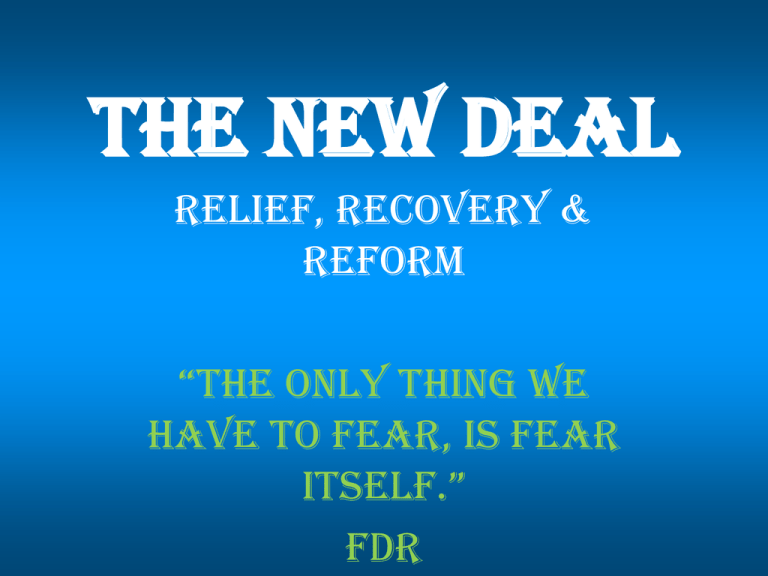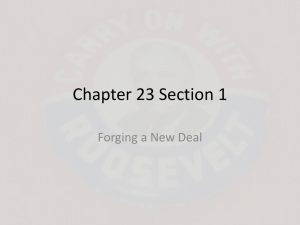The New Deal 2 - teacher notes
advertisement

THE NEW DEAL Relief, recovery & reform “The only Thing we have to fear, is fear iTself.” FDR RoosevelT’s vicToRy His administration began to immediately prove to the American people that they were different than that of Hoover. When FDR took office, a flurry of activity began and did not end for three months (March – June 1933). A lot of legislation was passed in this time that became known as the “Hundred Days”. FDR focused on the three “R’s”—relief, recovery and reform. FDR’s approach – “It is common sense to take a method and try it. If it fails, admit it frankly and try another, But above all, try something.” The Hundred Days In the first three months FDR got Congress to pass 15 major pieces of legislation – named New Deal legislation from a speech FDR gave promising the American people a new deal! These laws and others that followed, significantly expanded the federal government’s role in the nation’s economy. Saving the banks First things first—the bank crisis. FDR closed the banks on March 5, one day after taking office! The Emergency Banking Act was created and authorized the government to inspect the health of banks. Banks in sound financial shape were reopened immediately. Those lacking assets would remain closed until the government could find a safe way for them to open. Saving the banks cont. FDR addressed the American people the night before the banks reopened in the first of his many “fireside chats”. FDR spoke to the American people over the radio and explained his New Deal programs and called for support of the banking system. FDR explained that when too many people demand their money in cash, banks would fail. PLAN WORKED—deposits exceeded withdraws. relief fera Federal Emergency Relief Admin. — Congress appropriated $500 million to be distributed by the FERA to state and local relief agencies. ½ the money was to be used to provide food and clothing to the unemployed, aged, and ill. ½ to go to support work relief programs. FDR however, did not like giving charity and wanted to put people back to work! Applicants waiting for jobs in front of FERA offices in New Orleans. Aaa Agricultural Adjustment Act 1933 —paid farmers a subsidy (financial assistance) to reduce production of crops and the number of animals raised. This would bring the supply down to meet the demand. Problem - by the time the AAA was established, farmers had already planted crops and farm animals had already produced young. Therefore, in order to meet the AAA guidelines, farmers had to plow under a portion of their crops and kill newborn animals. tva Tennessee Valley Authority 1933 —built dams in the Tennessee River Valley to turn the river’s water power into electricity. It also intended to enrich the land, to create fish-filled lakes that would in turn increase tourism and provide jobs for Tennessee Valley residents. Tennessee Valley Authority recovery Ccc Civilian Conservation Corps Put young men ages 18-25 to work building roads, developing parks, planting trees, and helping on flood control Employed nearly 3 million men by 1942 Paid $30 a month and $25 was automatically sent home to their families. Civilian Conservation Corps Cwa Civil Works Administration Provided 4 million immediate jobs many claimed that the programs were “makework” projects and a waste of money But, they built 40,000 schools and ½ million miles of roads. Working for the CCC Pwa & nira Public Works Administration—put people to work building dams, refurbishing government buildings, planning sewage systems and improving highways. National Industrial Recovery Act—created the National Recovery Administration to help factories recover. relaxed anti-trust laws and called for business leaders to establish codes to set quality standards, production levels, prices, maximum working hours and minimum wages. It declared that workers could organize unions and penalized business leaders that did not adhere to their standards. (Posted the blue eagle in window). National Recovery Administration “Blue Eagle” emblem reform Regulating Banking and Finance Glass-Steagall Act of 1933 Established the Federal Deposit Insurance Corporation (FDIC) – provided federal insurance for individual bank accounts of up to $5,000. Federal Securities Act of 1933 Required corporations provide complete info. on all stock. Securities and Exchange Commission (SEC) regulated the stock market by preventing people with inside information from “rigging” the stock market for their own profit. Haters FDR faced many critics that believed his programs did not do enough, gave the federal government too much control over agriculture and industry, and interfered with the free-market economy. Deficit Spending • Roosevelt used the policy of deficit spending to finance his many programs. • Deficit spending= spending more money than the government receives in revenue. • FDR was reluctant to practice this but he believed it was a necessary evil. Tenant farmers • AAA—what did it do? • Tenant farmers were evicted from land to reduce acreage. • Went into effect late. Crops were tilled under and animals killed. • People could not understand this waste when many were going hungry. Business • NIRA permitted workers to join unions which led to strikes and hurt business. • Business leaders felt that Roosevelt interfered too much. republicans • Did not like that the New Deal created “big government”. Courts • Supreme Court overturned both the AAA and the NIRA. • Declared that the AAA was unconstitutional because agriculture is a local matter that should be regulated by the states rather than the federal government. • Declared that the NIRA gave the executive branch too much power. Huey Long • Senator Huey Long of Louisiana was the New Deal’s biggest challenger. • Long was eager to win the presidency himself and proposed a program called “Share Our Wealth” in which he promised something for everyone and economic equality for all. • Long was assassinated in 1935. • * refer to the reading on Huey Long* The court packing bill February 1937—“The Court Packing Bill”. - It would allow FDR to appoint 6 additional Supreme Court Justices. - Roosevelt claimed: The justices were old and he wanted to lighten their workload. - People thought: He was trying to get a court which would be sympathetic to his New Deal. The court packing bill - Bill - Didn’t happen, at least not through legislation. - 1937 an old justice retired and Roosevelt was able to appoint a liberal judge and in the next four years was able to appoint 7 new justices, shifting the court in favor of his programs. - This allowed FDR to pass more legislation with confidence that the SC would not rule against it. The second new deal The second new deal The Second New Deal was another series of sweeping legislation in many different areas. The new laws expanded relief programs, aided farmers and workers and provided economic reforms. It too focused on the three “R’s”— relief, recovery and reform. relief Wpa Works Project Administration—despite the success of the first New Deal, 10 million people remained unemployed in 1934. This program employed people building hospitals, schools, airports and playgrounds. It also employed teachers, artists, writers and actors. ssa Social Security Act— created the Social Security System headed by Francis Perkins. – Old-age insurance for retirees and their spouses – Unemployment compensation – Aid to families with dependant children and the disabled – One of the most important achievements of the New Deal!!!! recovery Wagner, SCA & REA Wagner Act—restored the rights to join unions and bargain collectively that had been lost when the NIRA was declared unconstitutional. Soil Conservation Act— paid farmers for cutting production of soil depleting crops and rewarded farmers for practicing good soil conservation methods. Rural Electrification – provided affordable electricity for isolated rural areas. reform PUhcA & Revenue Act Public Utility Holding Company Act— helped eliminate inefficiency in the utility industries and reduced consumer’s costs. Revenue Act— increased taxes on incomes of wealthy corporations and individuals. Effects of the New Deal Women obtained high ranking government positions for the first time; - Francis Perkins became the 1st female cabinet member However, in most other areas of American society women were still discriminated against. Effects of the New Deal African Americans made some strides: - 100+ appointed to key gov. positions - Famous African-American singer Marian Anderson was invited by Eleanor Roosevelt to sing in front of the Lincoln Memorial on Easter Sunday. - First, African-American trade union was formed. However, many of FDR’s New Deal programs were discriminatory towards African Americans and FDR did not support antilynching legislation or an end to poll taxes. Effects of the New Deal Native Americans received government support: - Indian Reorganization Act of 1934 – worked toward providing more autonomy for Native Americans rather than forced assimilation. Thirties Culture People enjoyed movies as an escape from reality. Famous films of the 30’s included Gone With the Wind (1939), Snow White & the Seven Dwarfs (1937),and The Wizard of Oz (1939). Thirties Culture • Radio also offered entertainment. • Orson Welles, an actor, director, producer and writer created one of the most renowned radio broadcasts of all time, “The War of the Worlds” (1938). • President FDR delivered his Fireside Chats on the radio. He used them to describe his New Deal in words that common folk could understand. Thirties Culture • Art during the era, unlike movies and radio, reflected the sober serious attitude of the thirties. • E.g.—American Gothic (1930).0 John Steinbeck wrote the Grapes of Wrath (1939), which reveals the lives of Oklahomans who left the Dust Bowl and ended up in California, where their hardships continued. THE END








